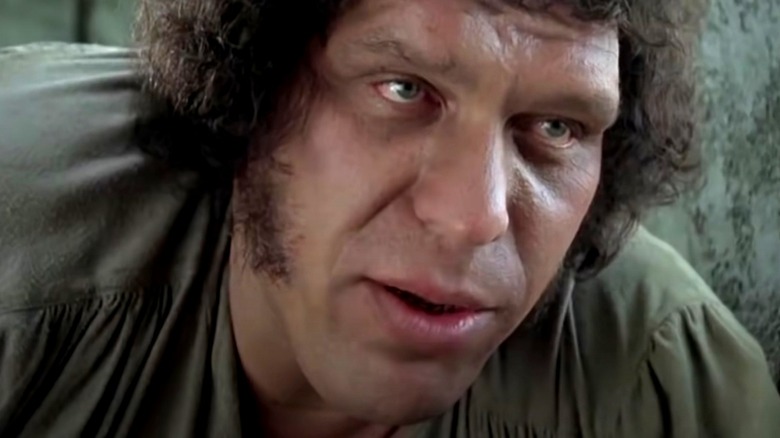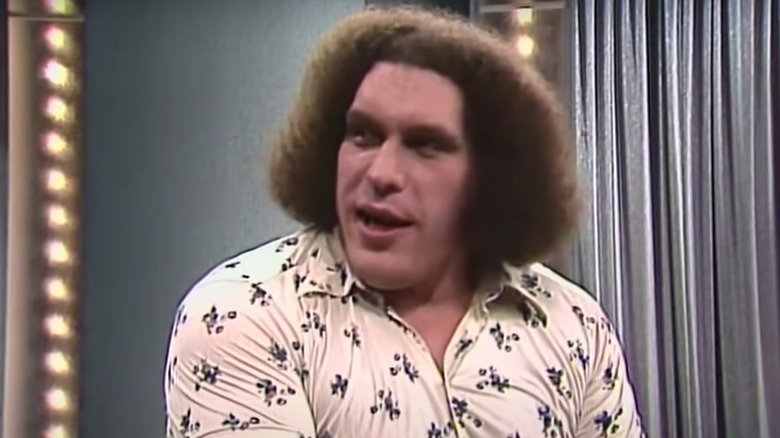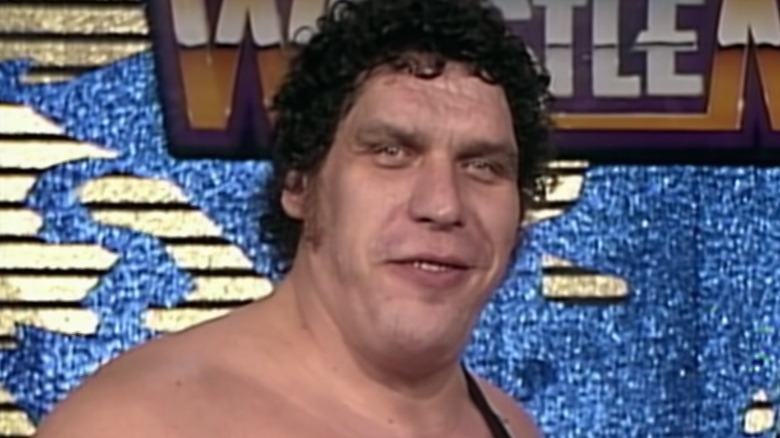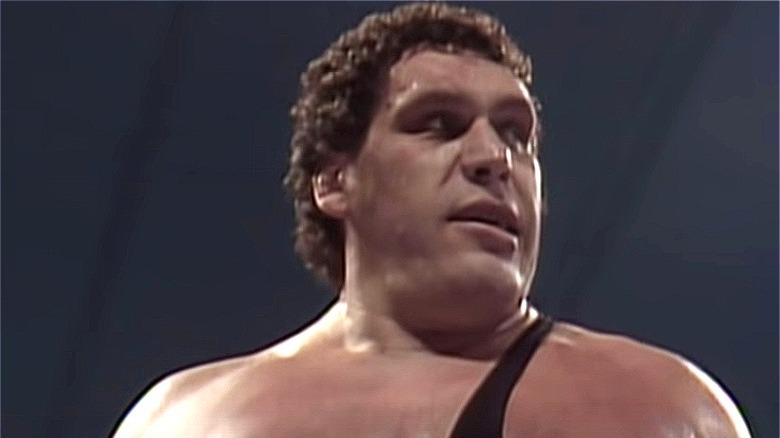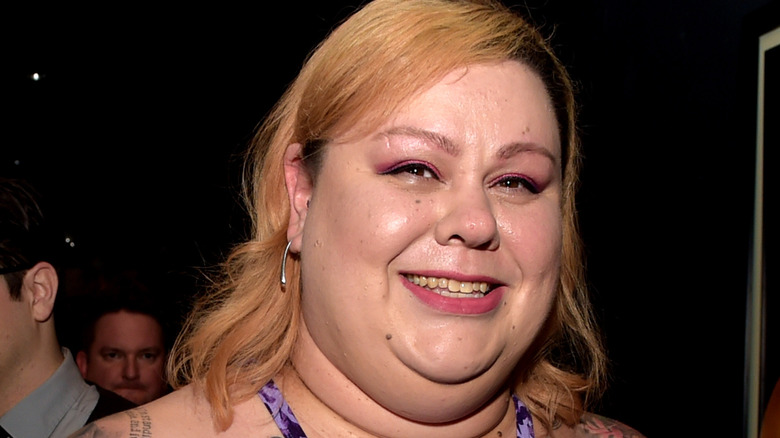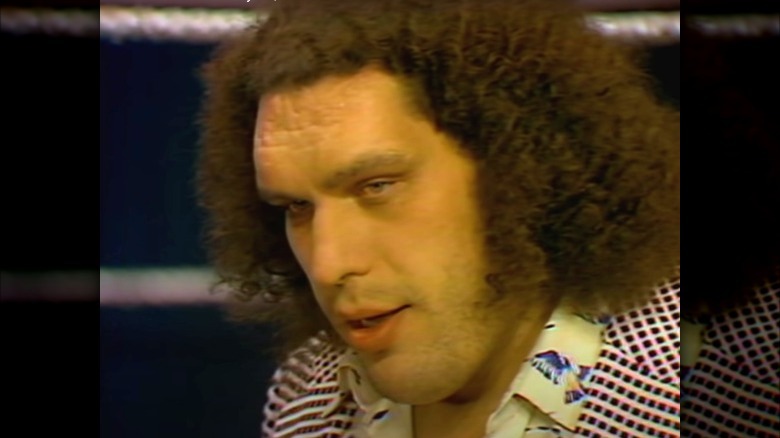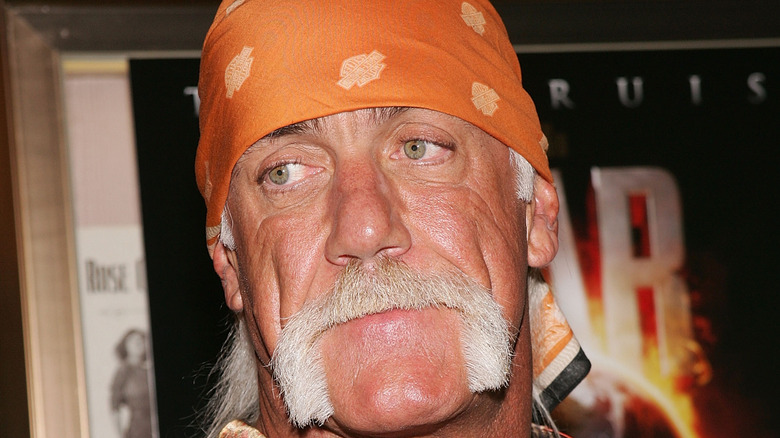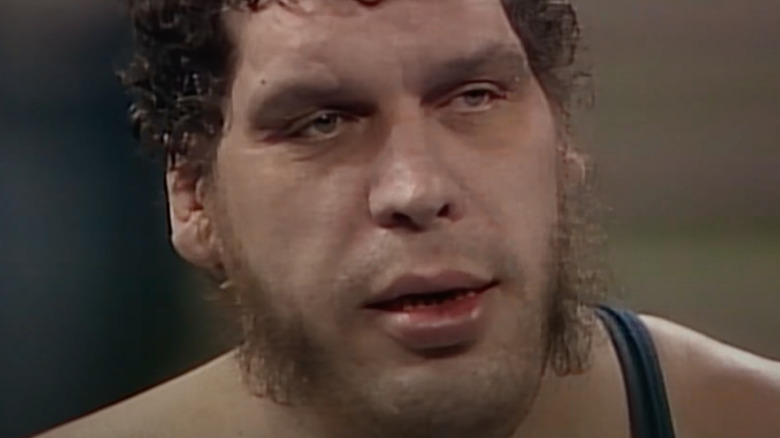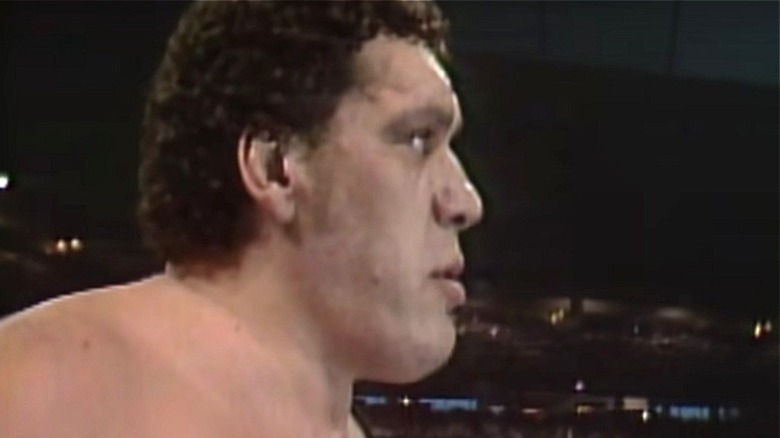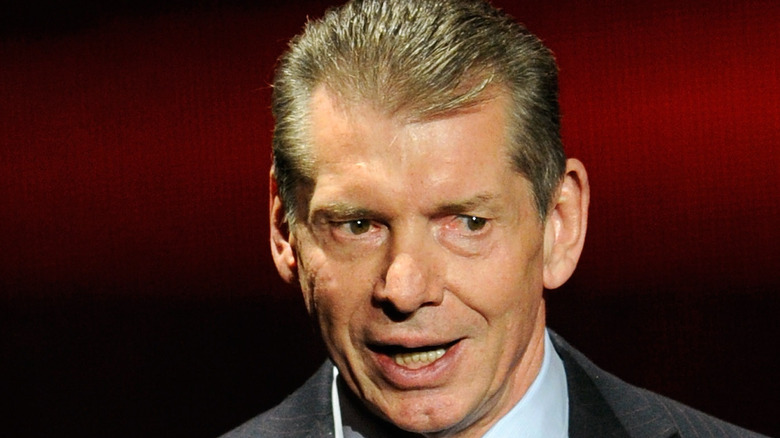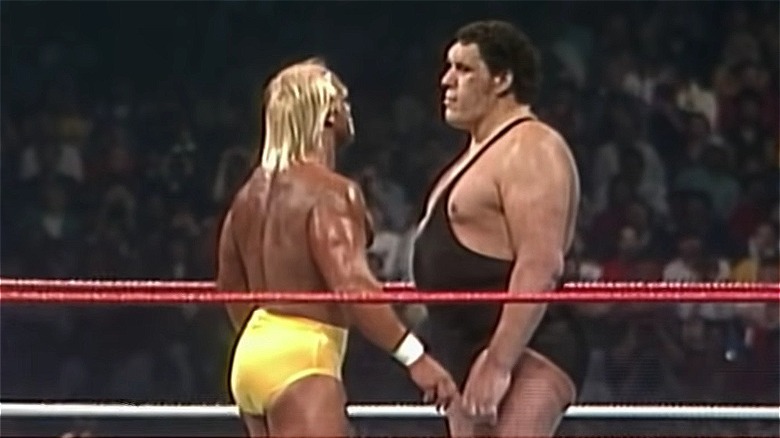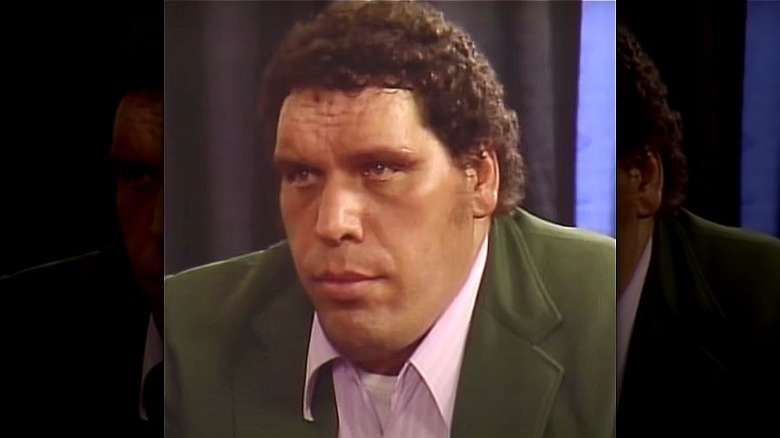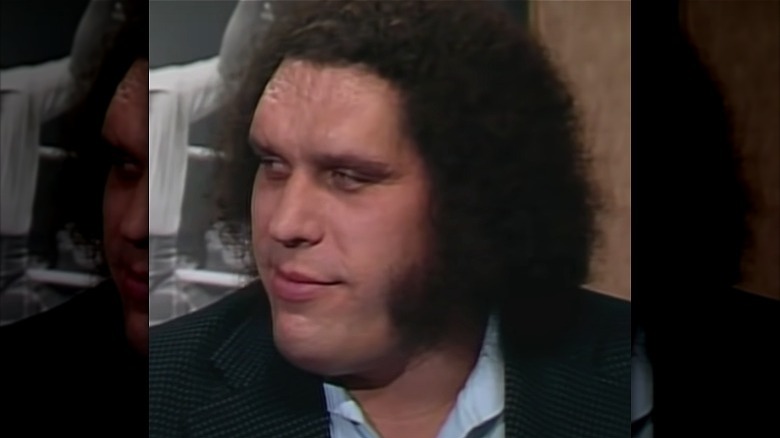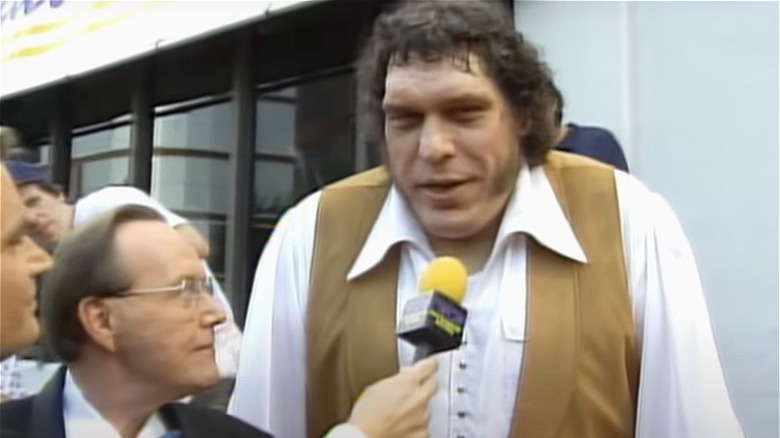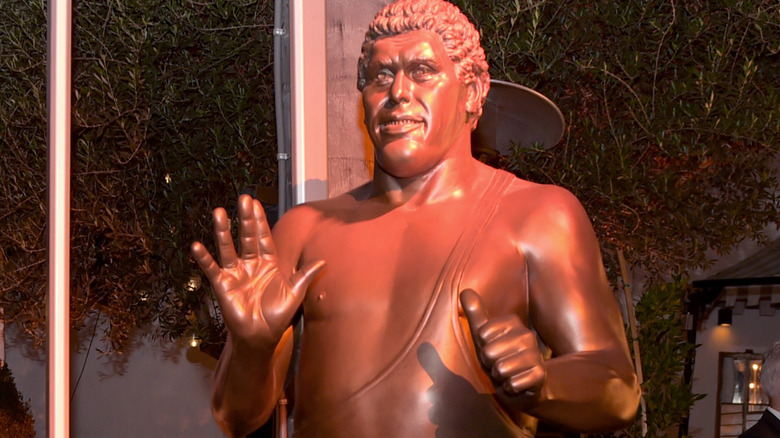The 14 Saddest Things About Andre The Giant's Life
If ever an individual embodied the term "gentle giant," it was the late Frenchman André René Roussimoff. You will, of course, know him better as André the Giant, the professional wrestler who after dominating the ring for the best part of the 1980s made an unlikely, albeit successful, pivot into acting when he was cast in "The Princess Bride."
Indeed, in contrast to his frame — he stood at 7 feet, 4 inches and weighed 520 pounds — the man known as the Eighth Wonder of the World was considered by those who knew him to be one of the sweetest, kindest, and most generous personalities outside the ring. As his "The Princess Bride" co-star Mandy Patinkin remembered in a video shared on Twitter, "He was beyond a gentle giant. He was just so wonderful. He was the spirit of the movie."
While the wrestling great had a career many would dream of, the road he took was far from easy. Throughout his life, which was cut short in 1993, André the Giant faced a number of hardships, obstacles, and tragedies.
André the Giant's upbringing was far from cushy
André the Giant had reportedly built up a sizable fortune by the time of his death in 1993. It was a far cry from his humble beginnings on the Roussimoff family farm in the rural French town of Molien, that's for sure. Per "The Eighth Wonder of the World," his parents made sure to always have enough food for André and his four siblings, but they never could afford a television set or gifts on holidays. What's more, his parents could not read, and books and newspapers were thin on the ground.
From an early age, André learned how to work hard. As André's brother Jacques Roussimoff said in the documentary "André the Giant: Most Famous Professional Wrestler in the World," "My parents were very cool. We had a lot of freedom. Of course, we had to work a lot because at that time, we didn't have a lot of money." André took jobs around the farm and gave working at a factory a try, but his whole world would change when he was invited to train as a wrestler in Paris. Per "The Eighth Wonder of the World," he didn't get paid for his training, so to make ends meet, he acted as a bodyguard for sex workers in the red-light district of Pigalle. At one point, his funds got so low that he resorted to sleeping in one of the city's metro's stations.
André the Giant was rejected from the French Army
We can't be sure whether André the Giant himself would have been hugely saddened or mightily relieved about this particular form of discrimination. But for many wannabe soldiers, being rejected from the military on the grounds of your height would be life-ruining.
Back in the Swinging Sixties, 75 percent of eligible Frenchmen aged 18 or over served for a year in the national army. And when André received a draft notice in 1965, he no doubt expected for it to be his turn. However, as noted in the documentary "André the Giant: Most Famous Professional Wrestler in the World," his height rendered him ineligible for service. Not only was he too tall to fit in trenches, but the equipment would be too small for him. So, rather than pack up and head to basic training, André got back to training for his professional wrestling career in Paris.
André the Giant's size made daily life unbearable
André the Giant may have made a fortune, journeyed the world, and become a star in both the wrestling ring and Hollywood due to his size. However, his build made a number of everyday tasks borderline impossible. As André said in a 1985 interview with CBC News, "They don't build anything for a giant. As I say, I have to live in your world."
Traveling was a particularly big problem, with very few airlines and hotels capable of accommodating André's unique measurements. In the HBO documentary "André the Giant," WWF referee and longtime friend Tim White remembered that instead of squeezing himself in a plane's compact bathroom stall, "The Princess Bride" star would urinate in a bucket hidden only by a curtain. In an interview with "The Voice Versus," Hulk Hogan lamented, "There was never a chair, there was never a knife, a fork, a bed, there was never a situation where he could be comfortable."
André also had to have all his clothes custom-made — his shoe size was apparently a colossal 24 — and even something as simple as making a phone call was a chore. As "André the Giant" director Jason Hehir told the New York Post, "[H]e couldn't dial a phone. He used to put a pencil in the holes of the rotary phone."
André the Giant barely saw his only child
André the Giant may have been hailed as one of the wrestling world's sweetest men by those who worked with him. But he was never going to win a Father of the Year award. Indeed, you can count on one hand the number of times that the star made the effort to see his only child. Robin Christensen-Roussimoff, whose mother Jean Christensen had an on/off relationship with the wrestler in the 1970s, only saw André on five occasions before his death. And as she later told CBS Sports, they weren't always during the most relaxed circumstances, either: "I can recall two or three times at arenas. Unfortunately, other times, they were in court."
Jackie McAuley, a longtime friend of André, claimed to the same network that the wrestler was left heartbroken by his lack of father-daughter time. So what exactly was it that kept them apart? Well, an understanding Christensen-Roussimoff later explained to "Wrestle Zone Radio Podcast," "We, unfortunately, did not have that great of a relationship. Mostly because he was on the road so much. I think it came to like 298 days out of the year in his prime."
However, Christensen-Roussimoff does not resent her late dad. Per "The Eighth Wonder of the World," she shared she believes he would've liked to have been in her life. "I fully understand that he couldn't be the father he probably wanted to be," she said.
He used alcohol to cope with his physical pain
As you might expect, it took a lot for André the Giant to get even a little tipsy, let alone anywhere near fully inebriated. As the story goes, the wrestler would often consume more than 100 beers in just one night. And he also reportedly could get through an entire case of wine before entering the ring.
Then there's the legend about the doctors who analyzed the wrestler's alcohol intake to try to figure out how much anesthesia to use. According to the account, André apparently said he could take down two liters of vodka before feeling anything, so the medical professionals ran with that. As Richard English recalled in a piece for Modern Drunkard Magazine, "The gas-passer was able to extrapolate a correct mixture for André by analyzing his alcohol intake. It was a medical breakthrough, and the system is still used to this day."
While the Frenchman's intake was often celebrated, it inevitably took a toll on his health. And on top of that, he used alcohol not for fun, but to deal with his existing physical discomfort. As his "The Princess Bride" co-star Cary Elwes later told the Daily Beast, "It should be pointed out that André didn't drink for the sake of drinking—André was in a lot of pain, God bless him. His back was injured from carrying all that weight around, and from having other wrestlers breaking chairs over his back."
He suffered during the famous Hulk Hogan match
The body slam heard around the world is one of the defining moments in the history of the WWE (née WWF). It refers to, of course, the moment that Hulk Hogan stormed to victory at 1987's WrestleMania III after body-slamming André the Giant (and then finishing with a running leg drop).
André was 520 pounds at the time; Hogan said he ended up tearing his latissimus dorsi muscle during the iconic move. Unsurprisingly, André had put a significant strain on his bones and joints and therefore spent the entirety of the match in excruciating pain. To make things worse, André had only just undergone surgery to his back, too.
As viewers could see for themselves during the famous bout, André struggled to walk around the ring, let alone execute any moves. In fact, he had to hold on to the ropes just to steady himself. But determined to put on a show, the star gave Hogan the green light to pull off the bodyslam toward the end of their encounter. "I tried so hard to give people something they'd never forget," the mustachioed muscleman later told Sports Illustrated. "André passed the torch to me, but he made me earn it."
André the Giant was ridiculed for his height
You might think that no one would be foolish enough to poke fun at a man that weighed approximately 520 pounds and stood over 7 feet. But apparently André the Giant was consistently ridiculed by members of the public throughout his short life. And such insults cut deep, too.
In 2018 HBO documentary "André the Giant," Hulk Hogan spoke of witnessing his former rival being taunted as they walked together through airports. Gene Okerlund also recalled how the WWF star was more sensitive than you may expect: "You never think a guy like that would cry, but he would cry." Even André's fans would make things difficult by pestering for autographs or to compare their hand sizes. Footage of André discussing the negative reactions he receives was also featured in the HBO doc. In one particularly sad scene, he tells longtime handler Tim White, "I wish I could be you for one weekend."
In an episode of "The Voice Versus," Hogan reflected on how much André endured. "He lived in a really cruel world and at the end of the day, when you really understood what he went through and what he was all about, he was a really gracious person with a kind heart," Hogan said. "But he didn't put up with any B.S."
André the Giant believed he couldn't treat his acromegaly
André the Giant was reportedly first officially diagnosed with acromegaly while wrestling in Japan in the 1970s, and then again on homegrown soil in the 1980s. As recalled by Dr. Harris Yett in the 2018 HBO documentary about the wrestler, the pituitary gland disorder which causes a dangerous increase in hormone growth could have been treated. However, the patient refused any kind of medical help on both occasions for two reasons. The first concern was that he had built his reputation as the Eighth Wonder of the World, and André didn't want to risk impacting his career. And second, he feared it would interfere with his faith.
On a 2020 episode of "Talk is Jericho," "The Eighth Wonder of the World" author Pat Laprade also dug into André's unwillingness to go under the knife to treat his acromegaly diagnosis. "He said God made him this way and he didn't want to change it. And he was also scared that his dimensions were going to change if he was getting the surgery ... he felt he would lose what made him special," Laprade said. "I have to think he was misinformed because he would not have changed that much."
In an interview with Playboy (via Dvaita), the Frenchman explained how his connection to a higher power had positively influenced him throughout his life. "I believe in God," he said. "I don't go to church every Sunday, but I believe in Him. I think He's helped me a lot."
Wild rumors followed André the Giant around
As well as having members of the public poke fun at his real statistics and gawk at him while he was out and about, André the Giant also had to cope with many jaw-dropping tales about his physical appearance that were the work of pure fiction. And many of these bizarre rumors were spread by his wrestling colleagues.
In the 2018 HBO documentary "André the Giant," WWE boss Vince McMahon gleefully recalled how he would fabricate stories about the Frenchman just to add to the mythology and spectacle. "You could say anything about André, and people would believe it," he stated. "The ring on his finger is bigger than your wrist. 'Oh, really! Okay ...' You can believe that. I used to say to people that André had 82 teeth, and they believed it! Yeah, and I said, 'It's kind of like when you see his teeth, and they're not real big, but they are rows of teeth like a shark behind him. No kidding!'"
Ric Flair also revealed that as a result, he could not help but think about the rumors whenever he came face to face with the late great. "Every time André talked to me, I'd be looking for that second row of teeth," he said. "I said, 'He couldn't have two rows of teeth. I could never see them!'" He went on to add that he did believe the legend that André was born with two hearts — yes, that was an actual rumor that went around.
André the Giant continued to push his body to its limits
Despite the fact he could barely even walk during his iconic 1987 Wrestlemania III encounter with Hulk Hogan, André the Giant continued to persevere with his wrestling career for another five years. Indeed, he competed in several other WWF flagship events, formed a tag team with Haku, and did some stints with All Japan Pro Wrestling and Mexico's Universal Wrestling Association.
Of course, by this point, the Frenchman was a shell of his former self, as his size and the array of injuries he'd picked up throughout his decades in the ring had taken a tremendous toll. Still, André was determined not to disappoint the fans who'd traveled to see him, even when he was in severe pain.
In a chat with CBS Sports, fellow wrestler Jake 'The Snake' Roberts recalled, "Toward the end, he probably shouldn't have been out there, but he was so amazing to see. He still put butts in seats. He carried himself well even though he couldn't walk fast. Him walking slow just made him look that much bigger." Hacksaw Jim Duggan concurred, adding, "Even towards the end, when he wasn't physically able to do too much, he would still get to the ring and let his tag team partner do most of the work, but at least let the fans get a look at André in the ring."
André the Giant couldn't always connect with others
André the Giant might have had millions of fans hanging on to his every word and every move, but outside of the ring, connecting with others did always not come easily to the colossal wrestling star. Though he was known for being a kind and gracious human, he was also an intimidating figure. As he once told Sports Illustrated, "Often, when I go to the homes of people who have small children, the children will run from me even though they have seen me on television. I understand why they do this, but it is a sad feeling for me, even so." Unfortunately, André was often only seen for his size, and that could get in the way of his personal life. As he said in People, "I don't really have too many friends. People want to be my friend because of my size. They want to take advantage of me. I don't like that."
That said, the late wrestling legend did form some strong, genuine friendships throughout his career. Speaking to CBS Sports, fellow wrestler Jake "The Snake" Roberts revealed that André also had high standards when it came to his loyal inner circle. "If he didn't have a relationship with you or didn't have something to share with you, then he didn't waste time with you," Roberts stated. "A lot of guys would try to brown-nose him and just make themselves look stupid in front of him. He didn't much care for that."
André the Giant's marriage fell apart
There seems to be some confusion over whether André the Giant officially wed Jean Christensen, the mother of his only child, back in the 1970s. According to Herald Net, they didn't register their marriage in the United States, but they did so in Canada. Whether they were legally tied together or not, their relationship sadly didn't last the distance.
In fact, Christensen, who met the Frenchmen while working as a seamstress in the wrestling world, and André separated shortly after they became parents. And daughter Robin Christensen-Roussimoff suspected her father's world was to blame. "There were too many other people surrounding him," she said, per Herald Net. "It was a common law marriage, they were together forever until she had me."
Although Christensen-Roussimoff and André barely saw each other in the years up to the wrestler's death, the former was still able to pay her late ex a compliment, even if it was a backhanded one. Per Herald Net, she said, "He was a huge man, I was making his clothes. It was the only time he looked good."
André the Giant spent his final days in grief
In January 1993, André the Giant learned that his father, Boris Roussimoff, was on his deathbed. The wrestler traveled from America back to his French hometown of Molien to be there for his father's funeral and subsequently decided to stay for a few more days in order to be there for his mother, Mariann Roussimoff, to ring in her birthday.
Sadly, in an interview with CBS Sports, friend Jackie McAuley revealed that photos from this period showed "The Princess Bride" star wasn't in a fit state to celebrate. "I saw pictures of him at his mother's birthday party and I was shocked." McAuley continued, "His skin was gray and powdery and his eyes were so deep. Before he went to France, I remember standing next to him at the table and popping his chest going, 'You got your barrel back; you need to lose some weight.'" Sadly, this warning came a little too late.
André's health had been declining for some time. Just a few months prior, he made his final television appearance on WCW. "He wasn't well, but Andre the Giant was Andre the Giant," announcer Tony Schiavone recalled years later, per Sports Illustrated. "You didn't think about what he was wearing or how he was feeling. He was just so big, that was his way of life."
André the Giant died just 46
André the Giant was once told that he'd be lucky to live to the age of 40 after being diagnosed with the pituitary gland disorder known as acromegaly. The wrestler did, in fact, make it to 46. But his untimely death still saddened the millions of wrestling and "The Princess Bride" fans across the world.
André's body was discovered in a Parisian hotel room in January 1993 by his chauffeur. Even more tragically, the Frenchman had only been in the capital to attend the funeral of his father, Boris Roussimoff. The cause of death was congestive heart failure. "He was lying in his bed when they found him," friend Frenchie Bernard told the Los Angeles Times. "He just went to sleep and never woke up."
Although his family initially planned to bury André next to his dad, they later learned of his wish to be cremated. His body was subsequently flown to America where his ashes were scattered at his North Carolina ranch. His daughter, Robin Christensen-Roussimoff, was later named as the sole beneficiary of his estate.

